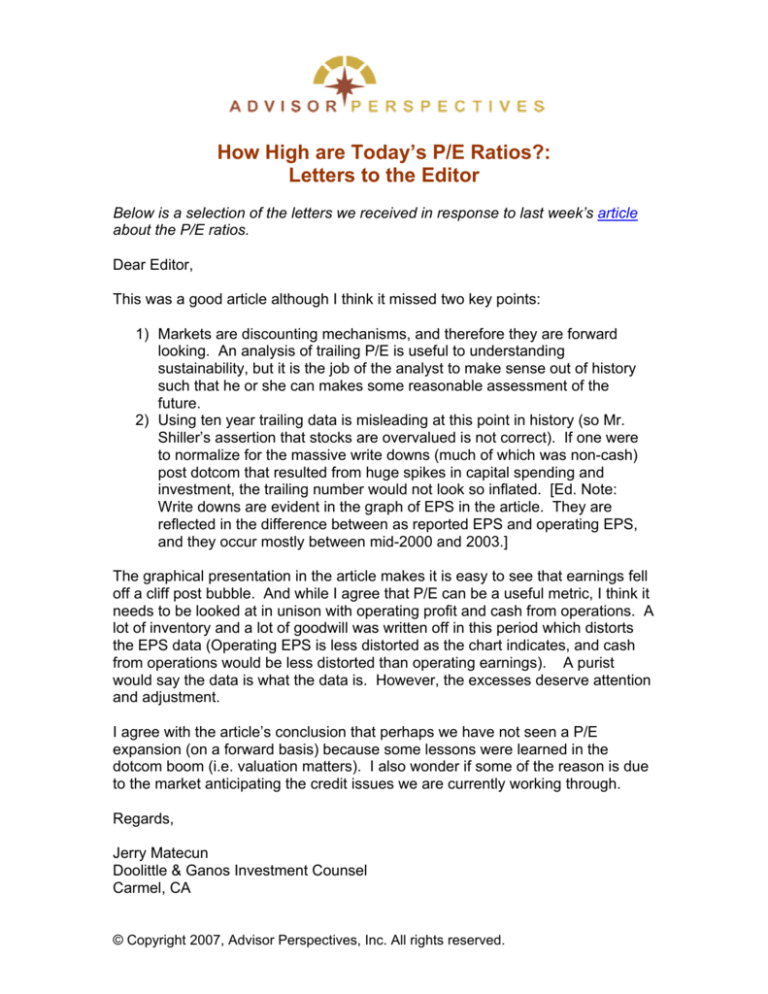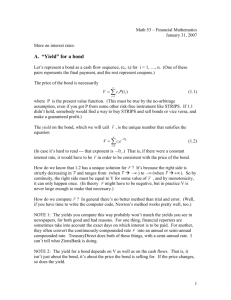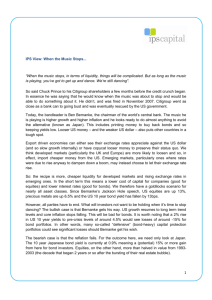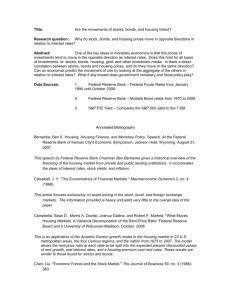
How High are Today’s P/E Ratios?:
Letters to the Editor
Below is a selection of the letters we received in response to last week’s article
about the P/E ratios.
Dear Editor,
This was a good article although I think it missed two key points:
1) Markets are discounting mechanisms, and therefore they are forward
looking. An analysis of trailing P/E is useful to understanding
sustainability, but it is the job of the analyst to make sense out of history
such that he or she can makes some reasonable assessment of the
future.
2) Using ten year trailing data is misleading at this point in history (so Mr.
Shiller’s assertion that stocks are overvalued is not correct). If one were
to normalize for the massive write downs (much of which was non-cash)
post dotcom that resulted from huge spikes in capital spending and
investment, the trailing number would not look so inflated. [Ed. Note:
Write downs are evident in the graph of EPS in the article. They are
reflected in the difference between as reported EPS and operating EPS,
and they occur mostly between mid-2000 and 2003.]
The graphical presentation in the article makes it is easy to see that earnings fell
off a cliff post bubble. And while I agree that P/E can be a useful metric, I think it
needs to be looked at in unison with operating profit and cash from operations. A
lot of inventory and a lot of goodwill was written off in this period which distorts
the EPS data (Operating EPS is less distorted as the chart indicates, and cash
from operations would be less distorted than operating earnings). A purist
would say the data is what the data is. However, the excesses deserve attention
and adjustment.
I agree with the article’s conclusion that perhaps we have not seen a P/E
expansion (on a forward basis) because some lessons were learned in the
dotcom boom (i.e. valuation matters). I also wonder if some of the reason is due
to the market anticipating the credit issues we are currently working through.
Regards,
Jerry Matecun
Doolittle & Ganos Investment Counsel
Carmel, CA
© Copyright 2007, Advisor Perspectives, Inc. All rights reserved.
Dear Editor:
I enjoyed the “How High Are Today’s P/E Ratios?” article. However, I take issue
with any discussion of P/E’s that doesn’t include the interest rate and the inflation
environments. I believe that inflation (or the perception of it) is the primary
determinant of interest rates and interest rates are the primary determinant of
relative stock values (P/E’s). As the following chart illustrates, there has been a
very close relationship between bond yields and earnings yields (earnings yield is
the inverse of the P/E ratio. A P/E of 20 is an earnings yield of 5%). Additionally,
using earnings yield provides a tool with which to directly compare bonds and
stocks.
While earnings yields are certainly more volatile than bond yields, it is not a
coincidence that today’s earnings yield (P/E ratio) is virtually the same as it was
40 years ago in the summer of 1967 – the AAA bond yields are the same too!
While the 1973 -1974 oil embargo and the resulting policy mistakes that
compounded an already inflationary environment are clearly visible, so is the 27
year decline in interest rates and earnings yields (which is also an expansion in
the P/E ratio!). Look at the inflection points since 1980 where earnings yields
and bond yields are very close; 1982, 1988, and 1994. Each of these points in
time was followed by multi year bull markets. This data series, which ends on
© Copyright 2007, Advisor Perspectives, Inc. All rights reserved.
6/30/2007, shows earnings yields and bond yields at parity. Based on the market
valuation work I do, the broad US stock market is more than 40% undervalued
at present. The next major move in the markets is much more likely to be up
than down.
The inflection points are important in that they represent points where the risk
premium between stocks and bonds has shrunk. A narrow spread indicates the
earnings yield on stocks is close to that of bonds. Given the long term superior
returns of stocks over bonds, buying stocks when they have almost the same
yield as bonds makes a lot of sense. Conversely, when the earnings yield on
stocks is significantly lower than that of bonds, (1983, 1987, 1999 – 2000) the
risks of owning stocks rise dramatically.
The last time the S&P 500 earnings yield was higher than the AAA bond yield
was in 1980. Since 1980, the AAA bond yield has, on average, been 2.5%
greater than the S&P 500 earnings yield. Today, the S&P 500 earnings yield is
greater than the AAA bond yield. The Federal Reserves own measure of the
stock market, which compares the estimated 12 month forward S&P 500
earnings yield with the 10 yr. Treasury yield, currently shows stocks undervalued
by approximately 50%. This dovetails closely with my own analysis that the
market is more than 40% undervalued.
The risk today is in bonds, not stocks.
Best wishes and Happy Holidays!
Patrick Slater
Alpha Investment Advisors, LLC
El Dorado Hills, CA
[Ed. Note: Robert Shiller recently published a paper that in part supports Mr.
Slater’s views, showing that ten year interest rates correlate with asset prices
inversely over time, although this correlation is subject to aberrations in the short
term.]
© Copyright 2007, Advisor Perspectives, Inc. All rights reserved.
Dear Editor:
This is an interesting piece, but I am a bear pessimist at heart regarding
investments/risk. I am not comfortable with what is going on right now in the
markets. Maybe I read too much Jim Jubak & Jon Markman from MSN Money,
but with all the financial industries clever product magic, it seems we are going to
suffer as the Financiers “reap what they have sown” in the economy. It just
seems a little strange that credit has dried up…the Fed is trying to push banks to
lend to one another & consumers, but they have not yet done so (from reports I
am hearing on the radio/internet). I am kind like an antelope drinking water on
the African Savannah sensing there is a lion nearby, but am not sure from which
direction it will come. Plus consider the other risk factors like rising oil prices and
heavy mortgage consumer debt. A stock bubble doesn’t seem comparable to me
when one is talking about real estate prices. The principles are the same with
high demand fueling the rise in prices, but isn’t real estate a slower animal to rise
and fall than equities? The transactions are not easy to make and the geography
of where a home is located affects the surrounding homes more so than a stock
in a similar industry affects another’s price. The prices and potential foreclosures
also seem to affect a much larger segment of the U.S. population which in turn
could seem to have a strong effect on the economy. The S & P 500 affects
consumer sentiment and the U.S. Economy, but people that lose money still
have a place to live. It seems if people are out of their homes due to
foreclosures it affects their mental psyche and spending more than losing money
in stock/mutual funds.
I will refer you to an article that spells doomsday for the economy. It seems
exaggerated but the narration of events doesn’t seem all that wild to me
regarding the behavior of the mortgage brokers and Wall Street. It seems to
make practical business sense. The finance industry is unregulated and they
have helped get us into trouble (consumers took loans that were too large for
them…despite the fact they may not have completely understood the leverage of
their mortgages, those individuals did make the decision to over-consume while
the brokers encouraged them on).
Cordially,
Richard S. Clive
Fraser Financial
Atlanta, GA
www.advisorperspectives.com
For a free subscription to the Advisor Perspectives newsletter, visit:
http://www.advisorperspectives.com/subscribers/subscribe.php
© Copyright 2007, Advisor Perspectives, Inc. All rights reserved.









